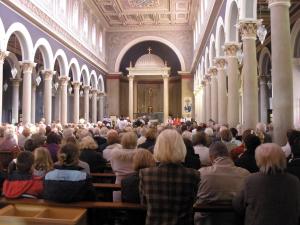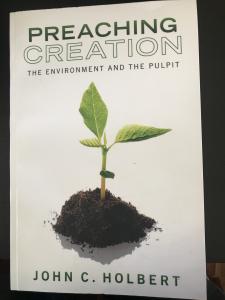 It appears more and more likely that my church, along with thousands of others this year will not be able to have Holy Week services with assembled parishioners. We will not see scenes like the one to the left. They will all need to be done at distance, using whatever technology those churches have available. My church’s first foray into this brave new world (at least I hope the world we are in is brave!) was checkered at best, with the signal sputtering in and out, freezing and jerking, matching perhaps the faith lives of those watching, or at least this person, me, attempting to watch. This Sunday we will try again, and I anticipate that a few of those digital bugs will have been squashed, if not at least held at bay a bit. As the Coronavirus pandemic drags on, churches will be more and more challenged to provide not only worship services, but also pastoral care for its members as well as outreach ministries to the broader community, the lifeblood of vast numbers of religious organizations.
It appears more and more likely that my church, along with thousands of others this year will not be able to have Holy Week services with assembled parishioners. We will not see scenes like the one to the left. They will all need to be done at distance, using whatever technology those churches have available. My church’s first foray into this brave new world (at least I hope the world we are in is brave!) was checkered at best, with the signal sputtering in and out, freezing and jerking, matching perhaps the faith lives of those watching, or at least this person, me, attempting to watch. This Sunday we will try again, and I anticipate that a few of those digital bugs will have been squashed, if not at least held at bay a bit. As the Coronavirus pandemic drags on, churches will be more and more challenged to provide not only worship services, but also pastoral care for its members as well as outreach ministries to the broader community, the lifeblood of vast numbers of religious organizations.
Maundy Thursday’s inevitable communion will be odd via televised images, and of course Easter with no live human beings jostling for a pew, many of whom prize this day above all days to attend, will be worthy of an episode of Twilight Zone. The blare of trumpets will likely be stilled, Handel’s ubiquitous chorus silent, children’s and bell choirs unsung and unrung. 2020 will be one for the church books, not easily forgotten, but readily and willingly dropped firmly in all of our rear view mirrors. Unfortunately, the death and disruption of the virus will not easily pass from our minds, nor should it. Too many of us have suffered and will suffer unspeakably and unimaginably from its invisible destruction of lives we treasured. We all need the church, and we all need our communities of believers to help us recover. All must pray that the beginning of that recovery may be soon.
Still, I must admit that one of the worship services I will not much miss during this peculiar Holy Week is Good Friday. I cannot begin to say how many dreadful Good Friday services I have both led and participated in. In various darkened and near-silent sanctuaries, I have watched black-robed volunteers extinguish candles, pound nails into wood, and shout lamentation as dramatic means to portray the horror of the day. Each of these playlets was designed to “encounter” (a favorite word used to describe what we were supposed to be experiencing) the events surrounding the capture, betrayal, trial, torture, and crucifixion of Jesus. The implication of all this appears to be the more we can feel the suffering of Jesus, the more we can “get into” what he felt in order that we may suffer, too, however vicariously, however, fleetingly. Tears are always welcome, accompanied by deep sighs and anguished slumped shoulders.
That monstrous pornographic blood fest of some years ago, “The Passion of the Christ,” directed by Mel Gibson, was a filmic paean to this way of thinking about Good Friday. For two hours, that seemed like two days, Gibson had his Jesus whipped, chained, dropped off a bridge, and mutilated with various torture devices, culminating in a close- up of his hands being nailed to the cross, one of the hands doing the nailing being Gibson’s own. This was the actor/director’s way of announcing that he had helped those Roman soldiers drive the spikes, and as such he needed the mercy of God to forgive him for such a dastardly deed. Here is a theology mirrored in that familiar Bach hymn, often sung during this service that includes the line, “I crucified thee.” The point of Good Friday, we are to conclude, is to convict us of our guilt in the death of Jesus and our need to wallow in that guilt until we are rung out in order that we may welcome an undeserved forgiveness from Jesus’s God.
I find this way of thinking about Good Friday both dangerous and appalling. Portraits of women singers with makeup smeared by tears and men stooped and crying in agony are not to me what this day is all about. Let me first say that I am not completely surprised by the way in which the Markan scene is often reenacted. There are gruesome details enough in his account to satisfy anyone with a bent toward dramatic suffering and wailing. From the purple cloak, the crown of thorns, the mocking of the bystanders as Jesus hangs in agony on that cross, the images are fixed into the minds and hearts of all serious Christians and have become part and parcel of the cultures of Christians around the world. But is all this merely designed to make comfortable Christians “suffer” a tad for one hour on a Friday, knowing all too well that the fun of Easter is not far away? If the point is suffering, of identification with the pain of Jesus, then why not join the New Mexican penitentes and actually allow oneself to be nailed to a cross? Now there is real suffering!
Mark has written his gospel to warn his readers that to follow this one is to sacrifice and perhaps to suffer indignity, rejection, and the demand for genuine change. He has painted his Good Friday scene in such a way as to reinforce that theme: the disciples’ continuous inability or unwillingness to understand and to follow the demands that Jesus gives them. Mark does not want his readers to recreate the pain of Jesus in their own bodies; he wants them to witness his pain and to search their own lives for ways that they can find new life in the face of that free gift of his life. Jesus’s suffering at the hands of the Romans is the seal on his willingness to stand over against the world order that Rome represents. He goes to his death willingly and freely, because he announces thereby that the Roman way is not God’s way. As he dies on the cross, he is flanked by two “rebels” (the word he used earlier to describe those who have misused the temple area (Mark 11:17), “on his right and left.” Those are the positions that the disciples sought when they imagined that following Jesus would lead to success and power as the world defines those things (Mark 10:37, 40). But Jesus does not offer worldly power and success; he rejects them because he knows that that way is not the way of God, the God who cares for the poor and the oppressed, the marginalized, the rejected.
You and I did not crucify Jesus that long ago day on Golgotha, but we do reject him when we fail to heed what he has come to do, namely to change the world away from Roman power to God’s love. We are not called to suffer like Jesus; we are called to witness his suffering and to alter our lives for the transformation of the world in his image of selfless giving for all. Mark uses an unnamed Roman soldier to make his central point: “When the Roman officer standing opposite him saw that he died like this,” that is like an innocent one publically tortured for all to see and hear, “he said, ‘this man really was God’s son’” (Mark 15:39). And because Jesus is in reality either a son of God or the son of God (the Greek grammar yields either reading), the reason for his coming is made
plain by Mark at 10:45: “to give his life as a ransom for many.” That word “ransom” was often used as the price paid to redeem a slave, and is found regularly in the Hebrew Bible to announce God’s “redeeming” of Israel (see Exodus 15:13; Psalm 106:10; Isaiah 43:1, among many others). Jesus is the bringer of freedom to the captives and the oppressed, and Mark calls all of us to join him, not in his cruel sufferings, though some few may be called to such, but rather to join him in his actions for freedom, based on the love he bears for all. Good Friday is only “good” when it effects change in us, not when we celebrate and recreate the suffering of Jesus. Please, no more nail pounding or tear- stained love songs to the tortured Jesus! Let us use Good Friday as the announcement of our willingness to change our lives to look more like his, lives that are given freely for others, lives motivated to love all in his name.
(Images from Wikimedia Commons)











